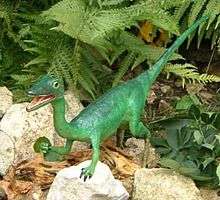Löwenstein Formation
| Löwenstein Formation Stratigraphic range: Norian | |
|---|---|
| Type | Geological formation |
The Löwenstein Formation (Stubensandstein in Baden-Württemberg, Burgsandstein in Bavaria) is a lithostratigraphic formation of the Keuper in Germany. It is underlain by the Mainhardt Formation and overlain by the Trossingen Formation. It dates back to the middle Norian.[1]
Vertebrate fauna
Dinosaurs
Theropod tracks and an unnamed herrersaur genus are known from the Lower Stubensandstein.[2]
Color key
|
Notes Uncertain or tentative taxa are in small text; |
| Dinosaurs and Archosaurs of the Stubensandstein | ||||||
|---|---|---|---|---|---|---|
| Genus | Species | Location | Stratigraphic position | Material | Notes | Images |
|
D. cristatus[3] |
|
"Tibia."[4] |
Actually indeterminate ceratosaur remains.[3] |
 Life restoration of Plateosaurus gracilis, formerly known as Sellosaurus gracilis | ||
|
H. longotarsus[3] |
|
"Mandibular fragment, vertebrae, humerus, illium, femur, metatarsal."[4] |
Actually indeterminate ceratosaur remains.[3] | |||
|
P. giganteus |
"Partial pedes."[5] |
|||||
|
P. diagnosticus [3] |
|
Actually Sellosaurus gracilis remains. Yates assigned the type material of Sellosaurus gracilis to Plateosaurus gracilis [6] | ||||
|
P. triassicus[3] |
|
"Partial postcranial skeleton."[7] |
||||
|
S. fraasi[3] |
|
Yates assigned the type material of Sellosaurus gracilis to Plateosaurus gracilis [6] | ||||
|
S. gracilis[8] |
"[Twenty one] partial skeletons, isolated elements, [three] partial skulls, juvenile to adult."[5] |
Yates assigned the type material of Sellosaurus gracilis to Plateosaurus gracilis [6] | ||||
|
T. minor[3] |
|
Galton and Benton showed that Teratosaurus is actually a rauisuchian.[9][10] | ||||
|
T. trossingensis[3] |
|
Galton and Benton showed that Teratosaurus is actually a rauisuchian.[9][10] | ||||
|
T. hermannianus[3] |
|
Thecodontosaurus hermannianus was named by Huene (1905), and then recombined as Sellosaurus hermannianus by Huene (1914). Smith and Pol (2007) recombined it as Plateosaurus gracilis[11] | ||||
See also
Footnotes
- ↑ Weishampel, David B; et al. (2004). "Dinosaur distribution (Late Triassic, Europe)." In: Weishampel, David B.; Dodson, Peter; and Osmólska, Halszka (eds.): The Dinosauria, 2nd, Berkeley: University of California Press. Pp. 521–525. ISBN 0-520-24209-2.
- 1 2 "17.2 Baden-Wurrtemberg, Germany; 1. Lower Stubensandstein," in Weishampel, et al. (2004). Page 524.
- 1 2 3 4 5 6 7 8 9 10 11 12 13 14 15 16 17 18 19 20 21 22 23 24 25 "17.2 Baden-Wurrtemberg, Germany; 2. Middle Stubensandstein," in Weishampel, et al. (2004). Page 524.
- 1 2 "Table 3.1," in Weishampel, et al. (2004). Page 50.
- 1 2 "Table 12.1," in Weishampel, et al. (2004). Page 236.
- 1 2 3 Yates, A.M. (2003). "Species taxonomy of the sauropodomorph dinosaurs from the Löwenstein Formation (Norian, Late Triassic) of Germany". Palaeontology 46 (2): 317–337
- ↑ "Table 3.1," in Weishampel, et al. (2004). Page 48.
- 1 2 "17.2 Baden-Wurrtemberg, Germany; '1. Lower Stubensandstein' and '2. Middle Stubensandstein,'" in Weishampel, et al. (2004). Page 524.
- 1 2 Galton, P. M. (1985). "The poposaurid thecodontian Teratosaurus suevicus von Meyer, plus referred specimens mostly based on prosauropod dinosaurs". Stuttgarter Beiträge zur Naturkunde, B, 116: 1-29.
- 1 2 Benton, M.J. (1986). "The late Triassic reptile Teratosaurus - a rauisuchian, not a dinosaur". Palaeontology 29: 293-301.
- ↑ N. D. Smith and D. Pol. 2007. Anatomy of a basal sauropodomorph dinosaur from the Early Jurassic Hanson Formation of Antarctica. Acta Palaeontologica Polonica 52(4):657-674
References
- Weishampel, David B.; Dodson, Peter; and Osmólska, Halszka (eds.): The Dinosauria, 2nd, Berkeley: University of California Press. 861 pp. ISBN 0-520-24209-2.
